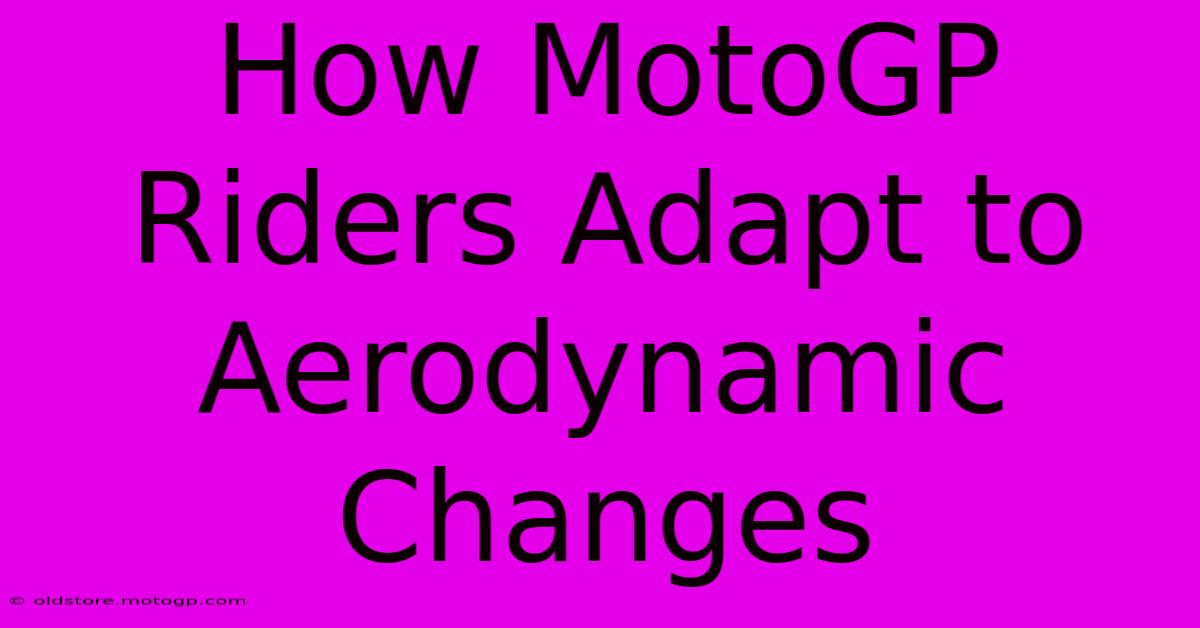How MotoGP Riders Adapt To Aerodynamic Changes

Table of Contents
How MotoGP Riders Adapt to Aerodynamic Changes
MotoGP, the pinnacle of motorcycle road racing, is a constant evolution. Every season brings advancements in technology, and a significant area of development is aerodynamics. These changes, however subtle or dramatic, demand significant adaptation from the riders, impacting their riding style, bike setup, and even their physical fitness. This article delves into how these elite athletes adjust to the ever-shifting aerodynamic landscape of MotoGP.
The Impact of Aerodynamic Changes
Aerodynamic improvements in MotoGP primarily focus on reducing drag and increasing downforce. Reducing drag allows for higher top speeds, while increased downforce improves stability at high speeds and through corners, allowing for later braking and faster corner exits. However, these changes are not simply beneficial additions; they significantly alter the bike's handling characteristics.
Changes in Handling and Stability
Increased downforce, while beneficial for stability, can make the bike feel heavier and less agile, especially at slower speeds and when changing direction. Riders must adapt to this increased inertia, requiring adjustments to their riding style and body positioning. Conversely, reduced drag might make the bike feel more nervous at high speeds, requiring greater control and precision.
The Role of Electronics
Modern MotoGP bikes heavily rely on sophisticated electronics to manage these changes. Traction control, anti-wheelie, and lean angle sensors help riders maintain control and prevent crashes, particularly when dealing with unexpected shifts in aerodynamic forces. The rider's ability to fine-tune these electronic aids is crucial to adapting to new aerodynamic packages.
Rider Adaptation Strategies
MotoGP riders are highly skilled and adaptable athletes. They employ several strategies to overcome the challenges posed by aerodynamic changes:
1. Track Time and Data Analysis
Extensive testing is crucial. Riders spend countless hours on the track, gathering data and experimenting with different settings to optimize their bike's performance with the new aerodynamics. This data, combined with feedback from the rider, allows the team to make necessary adjustments to the bike's setup and the rider's riding style.
2. Physical Training
Aerodynamic changes can place different demands on the rider's physical strength and endurance. Increased downforce can require greater upper body strength to hold the bike, while altered handling might necessitate more precision and control. Tailoring physical training to meet these demands is vital for optimizing performance.
3. Riding Style Adjustments
Adapting riding style is arguably the most critical aspect of adjusting to aerodynamic changes. This could involve adjusting body positioning, braking points, cornering techniques, and throttle control to compensate for the altered handling characteristics. This process is iterative, refining technique through continuous testing and data analysis.
4. Collaboration with the Team
The rider's relationship with their team – engineers, mechanics, and data analysts – is paramount. Open communication and a collaborative approach are vital for efficiently adapting to the new aerodynamics. The team's insights and support are crucial to making the necessary adjustments.
Conclusion: A Continuous Dance of Adaptation
The aerodynamic landscape of MotoGP is in constant flux. The ability of riders to adapt quickly and effectively to these changes is a critical determinant of their success. This requires a combination of skill, physical fitness, technological understanding, and close collaboration with their team. The ongoing dance between rider and machine, shaped by the ever-evolving aerodynamic dynamics, is what makes MotoGP such a compelling and fascinating sport.
Keywords: MotoGP, Aerodynamics, Rider Adaptation, Downforce, Drag, Motorcycle Racing, Handling, Electronics, Training, Riding Style, Technology, MotoGP Bikes, Data Analysis, Teamwork, Bike Setup

Thank you for visiting our website wich cover about How MotoGP Riders Adapt To Aerodynamic Changes. We hope the information provided has been useful to you. Feel free to contact us if you have any questions or need further assistance. See you next time and dont miss to bookmark.
Featured Posts
-
Cheap Formula 1 Austin Parking Does It Exist
Feb 20, 2025
-
Moto Gp Replay Revolutionizing The Way You Watch Racing
Feb 20, 2025
-
Austin Gp Concert Your Ultimate Guide To The After Party Scene
Feb 20, 2025
-
From Street To Track The Evolution Of Moto2 Bikes
Feb 20, 2025
-
The Secrets Of Moto Gp Success Strategies And Techniques
Feb 20, 2025
